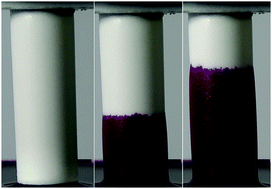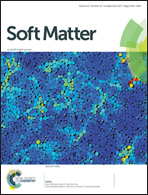Capillary uptake in macroporous compressible sponges†
Abstract
The capillarity-driven uptake of liquid in swellable, highly porous sponges is of significant industrial importance. Sponges prepared using polymers and their composites with carbon nanotubes and graphene have been reported, with extraordinary solvent uptake capacities and with the ability to separate oil from water. However, the effect of systematic variation of sponge characteristics on solvent uptake has not been investigated. Here, we report experiments that study capillary uptake in a variety of flexible, centimetre-sized macroporous cylindrical sponges. We used ice-templating to prepare a series of model macroporous sponges in which the porosity, modulus and composition were systematically varied. We investigated two kinds of sponge: (a) those composed purely of cross-linked polymers and (b) those prepared as composites of inorganic particles and polymers. Both kinds of sponge are flexible and exhibit elastic recovery after large compressive deformation. All sponges were characterized thoroughly with respect to their pore microstructure and elastic modulus. When one end of a sponge is plunged into a large reservoir, water rises through capillary action against gravity. We observed a transition from an inertial capillary regime, where the liquid column height rose linearly with time, t, to a viscous capillary regime, where the liquid height rose with time t0.5. We showed that these results can be rationalized using analyses developed for rigid sponges. We combined differential momentum balance equations for uptake in rigid capillaries with the phenomenological Ergun–Forchheimer relations to account for the effect of the sponge microstructure. This approach works remarkably well in the viscous capillary regime and shows that capillary uptake is governed primarily by the total porosity and pore dimensions of soft sponges.



 Please wait while we load your content...
Please wait while we load your content...